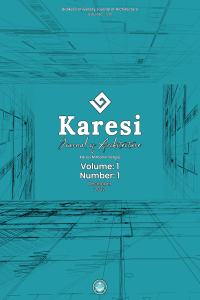AVLU YÖNÜ VE GENİŞLİĞİNİN BİNALARIN ENERJİ YÜKLERİNE ETKİSİNİN İNCELENMESİ
Avlu, Enerji Yükü, Enerji-Etkinliği, Enerji Benzetimi
INVESTIGATION OF THE EFFECT OF COURTYARD DIRECTION AND WIDTH ON ENERGY LOADS OF BUILDINGS
Courtyard, Energy Load, Energy Efficiency, Energy Simulation,
___
- Abanda, F.H. & Byers, L., 2016. "An investigation of the impact of building orientation on energy consumption in a domestic building using emerging BIM (Building Information Modelling)," Energy, Elsevier, vol. 97(C), pages 517-527.
- Abass, F., Ismail, L. H. & Solla, M. (2016). A review of courtyard house: hıstory evolution forms, and functions. ARPN Journal of Engineering and Applied Sciences, 11(4); 2557-2563.
- Acosta, I., Varela, C.; Molina, J. F.; Navarro, J. & Sendra, J. J. (2018). Energy efficiency and lighting design in courtyards and atriums: A predictive method for daylight factors. Applied Energy, 211; 1216-1228.
- Abdulkareem, H. A. (2016). Thermal Comfort through the Microclimates of the Courtyard. A Critical Review of the Middle-eastern Courtyard House as a Climatic Response. Procedia - Social and Behavioral Sciences, 216; 662-674.
- Allab, Y., Pellegrino, M., Guo, X., Nefzaoui, E. & Kindinis, A. (2017). Energy and comfort assessment in educational building: Case study in a French university campus. Energy and Buildings, 143, 202-219.
- Alwetaishi, M., Alzaed, A., Sonetti, G., Shrahily, R. & Jalil, L. (2018). Investigation of school building microclimate using advanced energy equipment: Case study, Environmental Engineering Research, 23(1), 10–20.
- Asfour, O. S. (2020). A comparison between the daylighting and energy performance of courtyard and atrium buildings considering the hot climate of Saudi Arabia. Journal of Building Engineering, 30: 101299.
- BRE. (2009). “BRE Environmental & Sustainability Standard,” BREEAM Court., no. 3: 368.
- Chi, F., Xu, Y. & Pan, J. (2022). Impact of shading systems with various type-number configuration combinations on energy consumption in traditional dwelling (China). Energy, 255: 124520.
- Chi, F., Xu, L. & Peng, C. (2020). Integration of completely passive cooling and heating systems with daylighting function into courtyard building towards energy saving. Applied Energy, 266:114865.
- Estidama sustainable buildings and communities and buildings program for the emirate of Abu Dhabi- design guidelines for new residential and commercial buildings; May 2008.
- Gil-Baez M., Barrios-Padura A., Molina-Huelva M. & Chacartegui R. (2017). Natural ventilation systems in 21 st-century for near zero energy school buildings. International Conference on Advances in Energy Systems and Environmental Engineering (ASEE17), 1187, Wrocław, Poland.
- Herrmann, H. & Bucksch, H. (2014). Mining subsidence Dictionary Geotechnical Engineering/Wörterbuch GeoTechnik, Springer Berlin Heidelberg, 879–879.
- Heydari, A., Sadati, S. E. & Gharib, M. R. (2021). Effects of different window configurations on energy consumption in building: Optimization and economic analysis. Journal of Building Engineering, 35: 102099.
- Karaca, U. B. (2022). A study on the improvement of indoor air quality in primary school classrooms. European Journal of Science and Technology, 33: 60-67.
- Kürekci, N.A. & Kaplan, S. (2014). Isıtma-soğutma yüklerinin HAP ve Revit Programlarıyla Hesaplanması. Tesisat Mühendisliği Dergisi, 141: 5-15.
- Liao, W., Wen, C.; Luo, Y.; Peng, J. & Li, N. (2022). Influence of different building transparent envelopes on energy consumption and thermal environment of radiant ceiling heating and cooling systems. Energy & Buildings, 255: 111702.
- Ministry of Housing and Construction, Ministry of Planning, 2013 Building Code of Iraq: Thermal Insulation Code, (PO Box 501), First Edition.
- Marwan, M. (2020). The effect of wall material on energy cost reduction in building. Case Studies in Thermal Engineering, 17: 100573.
- Mushtaha, E., Salameh, T.; Kharrufa, S.; Mori, T.; Aldawoud, A.; Hamad, R. & Nemer, T. (2021). The impact of passive design strategies on cooling loads of buildings in temperate climate. Case Studies in Thermal Engineering, 28: 101588.
- Najib, S. H. (2019). A proposal for an energy-efficient school building modelin Kirkuk/Iraq. Msc Thesis. Fırat University Graduate School of Natural and Applied Sciences, Elazığ.
- N. Harmati N. & Magyar, Z. (2015). Influence of WWR, WG and glazing properties on the annual heating and cooling energy demand in buildings,” Energy Procedia, 78: 2458–2463.
- Ouf, MM. & Issa, MH. (2017). Energy consumption analysis of school buildings in Manitoba, Canada, International Journal of Sustainable Built Environment, 6: 359–371.
- Pajek, L.; Potocnik, J. & Kosir, M. (2022). The effect of a warming climate on the relevance of passive design measures for heating and cooling of European single-family detached buildings. Energy & Buildings, 261: 111947.
- Sánchez de la Flor, F. J., Ruiz-Pardo, Á., Diz-Mellado, E., Rivera-Gómez, C. & Galán-Marín, C. (2021). Assessing the impact of courtyards in cooling energy demand in buildings. J. Clean. Prod., 320: 128742. Tabesh, T. & Sertyesilisik, B. (2015). An Investigation on Energy Efficient Courtyard Design Criteria. International Conference on Chemical, Civil and Environmental Engineering (CCEE-2015) Proceeding Book: 60-65, Istanbul (Turkey).
- Yacine Allab, Y.. Pellegrino, M.; Guo, X.; Nefzaoui, E. & Kindinis, A. (2017). Energy and comfort assessment in educational building: Case study in a French university campus. Energy and Buildings, 143: 202-219.
- URL-1 . https://www.scribd.com/doc/300504188/Syrian-Insulation-Code. Accessed: 24.10.2022.
- Başlangıç: 2022
- Yayıncı: Balıkesir Üniversitesi
BİR AMFİNİN HACİM AKUSTİĞİNİN MALZEME ALTERNATİFLERİ ÖNERİLEREK YENİDEN TASARLANMASI
Yasemin ÖZTÜRK, Zehra Tuğçe KAZANASMAZ, Mustafa Emre İLAL
AVLU YÖNÜ VE GENİŞLİĞİNİN BİNALARIN ENERJİ YÜKLERİNE ETKİSİNİN İNCELENMESİ
Salih Habib NAJİB, Betül BEKTAŞ EKİCİ
Yasemin BAL, Filiz ŞENKAL SEZER
MALATYA/BATTALGAZİ YERLEŞİMİNDE KORUMA-TURİZM İLİŞKİSİNİN İNCELENMESİ
